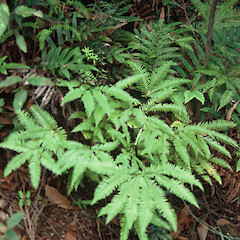Sticherus tener
Common name
silky fan fern
Synonyms
Gleichenia tenera R.Br., Mertensia tenera (R.Br.) Poir, Gleichenia flabellata var. tenera (R.Br.) Hook.f.
Family
Gleicheniaceae
Flora category
Vascular – Native
Endemic taxon
No
Endemic genus
No
Endemic family
No
Structural class
Ferns
Current conservation status
The conservation status of all known New Zealand vascular plant taxa at the rank of species and below were reassessed in 2017 using the New Zealand Threat Classification System (NZTCS) – more information about this can be found on the NZTCS website. This report includes a statistical summary and brief notes on changes since 2012 and replaces all previous NZTCS lists for vascular plants.
Please note, threat classifications are often suggested by authors when publications fall between NZTCS assessment periods – an interim threat classification status has not been assessed by the NZTCS panel.
- Conservation status of New Zealand indigenous vascular plants, 2017 . 2018. Peter J. de Lange, Jeremy R. Rolfe, John W. Barkla, Shannel P. Courtney, Paul D. Champion, Leon R. Perrie, Sarah M. Beadel, Kerry A. Ford, Ilse Breitwieser, Ines Schönberger, Rowan Hindmarsh-Walls, Peter B. Heenan and Kate Ladley. Department of Conservation. Source: NZTCS and licensed by DOC for reuse under the Creative Commons Attribution 4.0 International licence.
2017 | Threatened – Nationally Critical | Qualifiers: DP, RR, SO
Previous conservation statuses
2012 | Threatened – Nationally Critical | Qualifiers: DP, RR, SO
2009 | Non-resident Native – Vagrant | Qualifiers: SO, DP
2004 | Non-resident Native – Vagrant
Distribution
Indigenous. In New Zealand known from the Denniston Plateau (North Westland) and Five Fingers Peninsula, Resolution Island (Fiordland), where it said to be reasonably common (see Brownsey et al. 2013).
There has been some confusion over the distribution of Sticherus tener in New Zealand. Perrie (2013) stated: “Populations of Sticherus tener and Sticherus urceolatus in the northern South Island had previously been mistakenly attributed to Sticherus flabellatus. We now believe that Sticherus flabellatus does not occur in the South Island, but it is common in the northern North Island.”
Common in South Eastern Victoria and Tasmania.
Habitat
According to Brownsey et al. (2013), “Observations made from the recent collections indicate that plants occurred mostly around ridge tops in the northern half of Five Fingers Peninsula on slightly poorer soils under a low, semi-open canopy. The vegetation was usually low, mixed forest or scrub with Leptospermum scoparium, tall Halocarpus biformis, Lepidothamnus intermedius, Metrosideros umbellata and Nothofagus solandri var. cliffortioides, but S. tener also extended into taller beech/podocarp vegetation. Sticherus tener was never found in better soils on slopes.”
In Tasmania, where this species is abundant, it tends to grow in permanently damp soils along water courses and drainage lines within rainforest (often dominated by Nothofagus cunninghamii).
Detailed description
Stout fern forming dense colonies. Rhizome long creeping (up to 2 m long), 2–3 mm diameter, with dark brown ciliate scales. Frond yellow-green to green, composed of 1–4 tiers of opposite primary branches which in turn are divided 1–4 times; utlimate divisions linear to narrowly lanceolate; pinnules of first fork simple or lobed; dormant axillary buds conspicuous. Stipe 0.6–0.9 m long, glabrous except for basal scales; rachis bearing brown ciliate scales, glabrescent. Ultimate segments 8–20 × 2–3 mm wide, entire or rarely with distal portions irregularly crenate, set at an angle of 75º–90º to axis, glabrous above, with white to pale brown simple and branched hairs along the veins below. Sori of 3–6 sporangia set ⅓–½ the distance from the margin to the midrib; sporangia yellow-brown 2–3 mm diameter. (Description adapted from Chinnock & Bell (1998)).
According to Brownsey et al. (2013), S. tener has “a spreading frond with broad angles (c. 70°) between paired proximal pinnae. The ultimate leaflet is somewhat longer than the proximal costa (mean ratio 4.3 : 1). The proximal costa always bears leafy ultimate segments. The ultimate leaflet is linear or narrowly oblong in outline with the segments arising at almost a right angle (c. 80–85°) to the costa. The segments of the ultimate leaflet are more or less uniform in length, decreasing only at the apex, 8–15 mm long, 2–3 mm wide, entire, and green on the undersides. There are narrow, fimbriate, brown scales along the costae, and hair-like scales on the undersurfaces. Spores measure 33–37 mm by 17–18 mm (four samples from Denniston and one from Stockton).”
Similar taxa
Sticherus urceolatus and S. flabellatus are similar. See Brownsey et al. (2013) for a comparison of features.
In New Zealand this species differs from S. flabellatus by the mostly entire ultimate segments set at 75º–90º to the axis, and the smooth rhizomes. Sticherus tener and S. cunninghamii (Hook.) Ching may be sympatric. Sticherus cunninghamii differs from S. tener by its usually one tiered, distinctly more umbrella-like frond which is usually dark green above and white below, and has a much shorter more finely divided pinna.
Threats
Unknown in Fiordland. Threatened by opencast mining on the Denniston Plateau (Perrie 2013).
Etymology
sticherus: In rows; from the greek sticheres; arrangement of the spore clusters
Where To Buy
Not commercially available
Attribution
Fact sheet prepared for NZPCN by P.J. de Lange (March 2005). Description adapted from Chinnock & Bell (1998). Updated by Melissa Hutchison (19 November 2022), with reference to Brownsey et al. (2013).
References and further reading
Brownsey PJ, Ewans R, Rance B, Walls S, Perrie LR. 2013. A review of the fern genus Sticherus (Gleicheniaceae) in New Zealand with confirmation of two new species records. New Zealand Journal of Botany 51(2): 104–115. https://doi.org/10.1080/0028825X.2013.773917
Chinnock R.J.; and Bell G.H. 1998: Gleicheniaceae. Flora of Australia 48: 148–162.
Chinnock RJ, Bell GH. 1998. Gleicheniaceae. Flora of Australia 48, Ferns Gymnosperms and allied groups: 148–162. ABRS/CSIRO Victoria, Australia.
Perrie L. 2013. Would you mine a rare population? Blog on the Museum of New Zealand/Te Papa Tongarewa website. https://blog.tepapa.govt.nz/2013/04/21/would-you-mine-a-rare-population/



